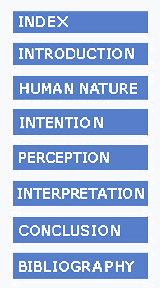|
CONCLUSION
"In art it is hard to say anything as good as: saying nothing"
(Wittgenstein 1980 p. 23e) The spectator enjoys the work in silence; in the inner sanctum of his privacy. The problem of interpretation what he sees become more complex when it needs to be communicated trough the use of a language that cannot capture the finer points of a visual system. It is wrong to think that a painting cannot express an emotion or feeling unless that emotion or feeling can be caught in language. This is not to criticize the use of language but to recognize its limitations. Wollheim claims that determinate meaning is linked to an individual recognition of intention, Bryson to the social recognition of the sign. Wollheim's general line of argument has been that paintings are produced by an artist, that his actions are intentional under some descriptions, that their explanation involves the artist's intention and therefore to understand a work of art we must understand the artist's action in terms of the intention that caused it. It seems plausible that relating some part of a picture to the artist's intention does make a difference in interpretation roughly in the way that what a person intends by an action makes a moral difference in our evaluation of that action. Yet Wollheim's account of meaning cannot explain all cases of generation of meaning. What of the myriad interpretations that coexist? interpretations according to Marxism, Semiotics and so on. Under these circumstance it may not seem advisable at all to use the word 'meaning' in speaking of painting. The term "meaning" when used in this context is vastly confusing. It derives its puzzling quality from the fact that it is meaningfully employed in other contexts and the person feels that it must mean something in this one. What is the meaning of this word? looks similar and seem like the same kind of question. but beneath the similarity of appearance, the meaning (reference) of the word "meaning" has changed, or vanished into nothing. However, if one wants to retain the word in speaking of painting, I would agree with Wollheim's view that suggests that a work of art means to us whatever effects it evokes in us as spectators looking at the surface of a painting. As we become more acquainted with the work of art, the effects it evokes in us gradually change, but in that case its meaning for us gradually changes too. The change should be a gradually 'rapprochement' to the artist's intended meaning. If its meaning no longer concurs with what the artist intended then the painting can be said to have 'significance' the painting means something to us. By contrast Bryson's materialism does not tell us what it is like to be affected by a painting. he is not interested in our psychology one would question such a detached view of art devoid of experience. What is the point of art? Why do artist paint? There are many answers but one of them must be because through painting they can express something that cannot be expressed in words. Yet problems do remain. Wollheim argues for the interpretation of paintings on the basis of how they are experienced: on the basis of what one sees, feels, and think . But given that one has the right sensitivity an information , how can it be certain that the experience is correct? How can it be said that this experience provides the spectator with an appropriate insight into the fulfilled aims and intentions of the artist? Wollheim would reply that painting as an art would not have continued without artists having some success in putting across what they wished to convey. Without such success it would have gone out of existence. The strongest argument is that painting has survived as an activity that gives meaning to and claims intelligibility for its output. This argument presupposes that if painting has continued to be admired, practised and valued over the ages and in different societies it is because we share a common human nature. If in each society human nature was a construct of that society painting would not have remained intelligible across the centuries. The problem with Wollheim's version of Intentionalism is that it holds meaning to be absolute, and if we use meaning in a broad sense then we have to acknowledge that only by abandoning this model that a number of different theories can be used to arrive at different explanations of a painting. The most correct theoretical argument may not bring out the best insights in painting. We do not know, and should to a point be doubtful, about where our concepts of viewing and knowing a person or picture end, and where our desires formed in our biological and cultural form of life begin. |
© 2024 Luigi Vanzan





